-
Getting Started with Citrix ADC
-
Deploy a Citrix ADC VPX instance
-
Optimize Citrix ADC VPX performance on VMware ESX, Linux KVM, and Citrix Hypervisors
-
Apply Citrix ADC VPX configurations at the first boot of the Citrix ADC appliance in cloud
-
Install a Citrix ADC VPX instance on Microsoft Hyper-V servers
-
Install a Citrix ADC VPX instance on Linux-KVM platform
-
Prerequisites for Installing Citrix ADC VPX Virtual Appliances on Linux-KVM Platform
-
Provisioning the Citrix ADC Virtual Appliance by using OpenStack
-
Provisioning the Citrix ADC Virtual Appliance by using the Virtual Machine Manager
-
Configuring Citrix ADC Virtual Appliances to Use SR-IOV Network Interface
-
Configuring Citrix ADC Virtual Appliances to use PCI Passthrough Network Interface
-
Provisioning the Citrix ADC Virtual Appliance by using the virsh Program
-
Provisioning the Citrix ADC Virtual Appliance with SR-IOV, on OpenStack
-
Configuring a Citrix ADC VPX Instance on KVM to Use OVS DPDK-Based Host Interfaces
-
-
Deploy a Citrix ADC VPX instance on AWS
-
Deploy a VPX high-availability pair with elastic IP addresses across different AWS zones
-
Deploy a VPX high-availability pair with private IP addresses across different AWS zones
-
Configure a Citrix ADC VPX instance to use SR-IOV network interface
-
Configure a Citrix ADC VPX instance to use Enhanced Networking with AWS ENA
-
Deploy a Citrix ADC VPX instance on Microsoft Azure
-
Network architecture for Citrix ADC VPX instances on Microsoft Azure
-
Configure multiple IP addresses for a Citrix ADC VPX standalone instance
-
Configure a high-availability setup with multiple IP addresses and NICs
-
Configure a high-availability setup with multiple IP addresses and NICs by using PowerShell commands
-
Configure a Citrix ADC VPX instance to use Azure accelerated networking
-
Configure HA-INC nodes by using the Citrix high availability template with Azure ILB
-
Configure a high-availability setup with Azure external and internal load balancers simultaneously
-
Configure address pools (IIP) for a Citrix Gateway appliance
-
Upgrade and downgrade a Citrix ADC appliance
-
Solutions for Telecom Service Providers
-
Load Balance Control-Plane Traffic that is based on Diameter, SIP, and SMPP Protocols
-
Provide Subscriber Load Distribution Using GSLB Across Core-Networks of a Telecom Service Provider
-
Authentication, authorization, and auditing application traffic
-
Basic components of authentication, authorization, and auditing configuration
-
On-premises Citrix Gateway as an identity provider to Citrix Cloud
-
Authentication, authorization, and auditing configuration for commonly used protocols
-
Troubleshoot authentication and authorization related issues
-
-
-
-
-
-
-
Persistence and persistent connections
-
Advanced load balancing settings
-
Gradually stepping up the load on a new service with virtual server–level slow start
-
Protect applications on protected servers against traffic surges
-
Retrieve location details from user IP address using geolocation database
-
Use source IP address of the client when connecting to the server
-
Use client source IP address for backend communication in a v4-v6 load balancing configuration
-
Set a limit on number of requests per connection to the server
-
Configure automatic state transition based on percentage health of bound services
-
-
Use case 2: Configure rule based persistence based on a name-value pair in a TCP byte stream
-
Use case 3: Configure load balancing in direct server return mode
-
Use case 6: Configure load balancing in DSR mode for IPv6 networks by using the TOS field
-
Use case 7: Configure load balancing in DSR mode by using IP Over IP
-
Use case 10: Load balancing of intrusion detection system servers
-
Use case 11: Isolating network traffic using listen policies
-
Use case 12: Configure Citrix Virtual Desktops for load balancing
-
Use case 13: Configure Citrix Virtual Apps for load balancing
-
Use case 14: ShareFile wizard for load balancing Citrix ShareFile
-
Use case 15: Configure layer 4 load balancing on the Citrix ADC appliance
-
-
-
-
Authentication and authorization for System Users
-
-
Configuring a CloudBridge Connector Tunnel between two Datacenters
-
Configuring CloudBridge Connector between Datacenter and AWS Cloud
-
Configuring a CloudBridge Connector Tunnel Between a Datacenter and Azure Cloud
-
Configuring CloudBridge Connector Tunnel between Datacenter and SoftLayer Enterprise Cloud
-
Configuring a CloudBridge Connector Tunnel Between a Citrix ADC Appliance and Cisco IOS Device
-
CloudBridge Connector Tunnel Diagnostics and Troubleshooting
This content has been machine translated dynamically.
Dieser Inhalt ist eine maschinelle Übersetzung, die dynamisch erstellt wurde. (Haftungsausschluss)
Cet article a été traduit automatiquement de manière dynamique. (Clause de non responsabilité)
Este artículo lo ha traducido una máquina de forma dinámica. (Aviso legal)
此内容已经过机器动态翻译。 放弃
このコンテンツは動的に機械翻訳されています。免責事項
이 콘텐츠는 동적으로 기계 번역되었습니다. 책임 부인
Este texto foi traduzido automaticamente. (Aviso legal)
Questo contenuto è stato tradotto dinamicamente con traduzione automatica.(Esclusione di responsabilità))
This article has been machine translated.
Dieser Artikel wurde maschinell übersetzt. (Haftungsausschluss)
Ce article a été traduit automatiquement. (Clause de non responsabilité)
Este artículo ha sido traducido automáticamente. (Aviso legal)
この記事は機械翻訳されています.免責事項
이 기사는 기계 번역되었습니다.책임 부인
Este artigo foi traduzido automaticamente.(Aviso legal)
这篇文章已经过机器翻译.放弃
Questo articolo è stato tradotto automaticamente.(Esclusione di responsabilità))
Translation failed!
Deploy a VPX high-availability pair with private IP addresses across different AWS zones
You can configure two Citrix ADC VPX instances on two different subnets or two different AWS availability zones using private IP addresses in the INC mode. This solution can be easily integrated with the existing multizone VPX high-availability pair with elastic IP addresses. Therefore, you can use both the solutions together.
For more information about high availability, see High availability. For more information about INC, see Configuring high availability nodes in different subnets.
Note:
This deployment is supported from Citrix ADC release 13.0 build 67.39 onwards. This deployment is compatible with AWS Transit Gateway and VPC peering.
Prerequisites
Ensure that the IAM role associated with your AWS account has the following IAM permissions:
{
"Version": "2012-10-17",
"Statement": [
{
"Action": [
"ec2:DescribeInstances",
"ec2:DescribeAddresses",
"ec2:AssociateAddress",
"ec2:DisassociateAddress",
"ec2:DescribeRouteTables",
"ec2:DeleteRoute",
"ec2:CreateRoute",
"ec2:ModifyNetworkInterfaceAttribute",
"iam:SimulatePrincipalPolicy",
"iam:GetRole"
],
"Resource": "*",
"Effect": "Allow"
}
]
}
<!--NeedCopy-->
How to deploy a VPX high-availability pair with private IP addresses across different AWS zones
The following is the summary of steps for deploying a VPX pair on two different subnets or two different AWS availability zones using private IP addresses.
- Create an Amazon virtual private cloud.
- Deploy two VPX instances in two different availability zones.
- Configure high availability
- Set up high availability in INC mode in both the instances.
- Add the respective route tables in the VPC that points to the client interface.
- Add a virtual server in the primary instance.
For steps 1 and 2, use the AWS console. For step 3, use the Citrix ADC VPX GUI or the CLI.
Step 1. Create an Amazon virtual private cloud (VPC).
Step 2. Deploy two VPX instance in two different availability zones with the same number of ENI (Network Interface).
For more information about how to create a VPC and deploy a VPX instance on AWS, see Deploy a Citrix ADC VPX standalone instance on AWS and Scenario: standalone instance
Step 3. Configure the ADC VIP addresses by choosing a subnet that does not overlap with the Amazon VPC subnets. If your VPC is 192.168.0.0/16, then to configure ADC VIP addresses, you can choose any subnet from these IP address ranges:
- 0.0.0.0 - 192.167.0.0
- 192.169.0.0 - 254.255.255.0
In this example, the chosen 10.10.10.0/24 subnet and created VIPs in this subnet. You can choose any subnet other than the VPC subnet (192.168.0.0/16).
Step 4. Add a route that points to the client interface (VIP) of the primary node from the VPC route table.
From the AWS CLI, type the following command:
aws ec2 create-route --route-table-id rtb-2272532 --destination-cidr-block 10.10.10.0/24 --gateway-id <eni-client-primary>
<!--NeedCopy-->
From the AWS GUI, perform the following steps to add a route:
- Open the Amazon EC2 console.
- In the navigation pane, choose Route Tables, and select the route table.
- Choose Actions, and click Edit routes.
- To add a route, choose Add route. For Destination, enter the destination CIDR block, a single IP address, or the ID of a prefix list. For gateway ID, select the ENI of a client interface of the primary node.
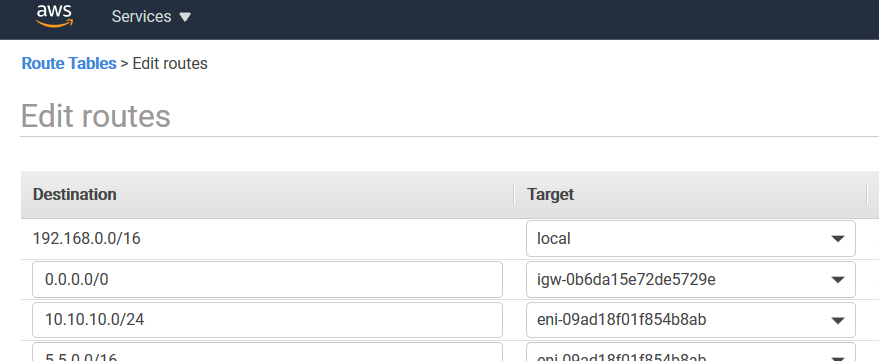
Note
You must disable Source/Dest Check on the client ENI of the primary instance.
To disable the source/destination checking for a network interface using the console, perform the following steps:
- Open the Amazon EC2 console.
- In the navigation pane, choose Network Interfaces.
- Select the network interface of a primary client interface, and choose Actions, and click Change Source/Dest. Check.
- In the dialog box, choose Disabled, click Save.
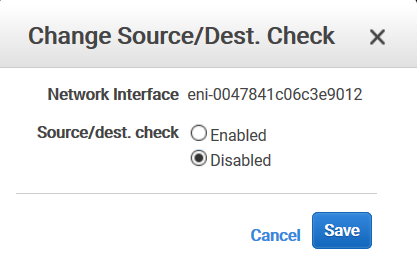
Step 5. Configure high availability. You can use the Citrix ADC VPX CLI or the GUI to set up high availability.
Configure high availability by using the CLI
-
Set up high availability in INC mode in both the instances.
On the primary node:
add ha node 1 \<sec\_ip\> -inc ENABLED <!--NeedCopy-->On the secondary node:
add ha node 1 \<prim\_ip\> -inc ENABLED <!--NeedCopy--><sec_ip> refers to the private IP address of the management NIC of the secondary node.
<prim_ip> refers to the private IP address of the management NIC of the primary node.
-
Add a virtual server on the primary instance. You must add it from the chosen subnet, for example, 10.10.10.0/24.
Type the following command:
add \<server\_type\> vserver \<vserver\_name\> \<protocol\> \<primary\_vip\> \<port\> <!--NeedCopy-->
Configure high availability by using the GUI
-
Set up high availability in INC mode on both the instances
-
Log on to the primary node with user name
nsrootand instance ID as password. -
Navigate to Configuration > System > High Availability, and click Add.
-
At the Remote Node IP address field, add the private IP address of the management NIC of the secondary node.
-
Select Turn on NIC (Independent Network Configuration) mode on self-node.
-
Under Remote System Login Credential, add the user name and password for the secondary node and click Create.
-
Repeat the steps in the secondary node.
-
Add a virtual server in the primary instance
Navigate to Configuration > Traffic Management > Virtual Servers > Add.
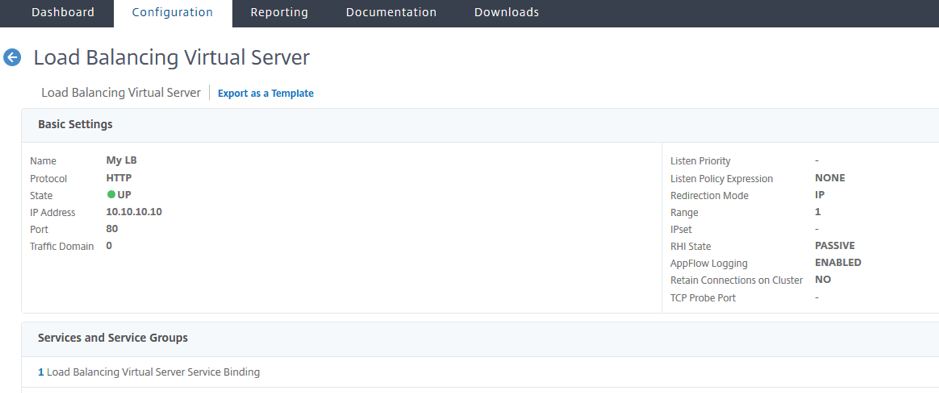
Scenario
In this scenario, a single VPC is created. In that VPC, two VPX instances are created in two availability zones. Each instance has three subnets - one for management, one for client, and one for back-end server.
The following diagrams illustrate the Citrix ADC VPX high availability setup in INC mode, on AWS. The custom subnet 10.10.10.10, which is not part of the VPC is used as VIP. Therefore, the 10.10.10.10 subnet can be used across availability zones.
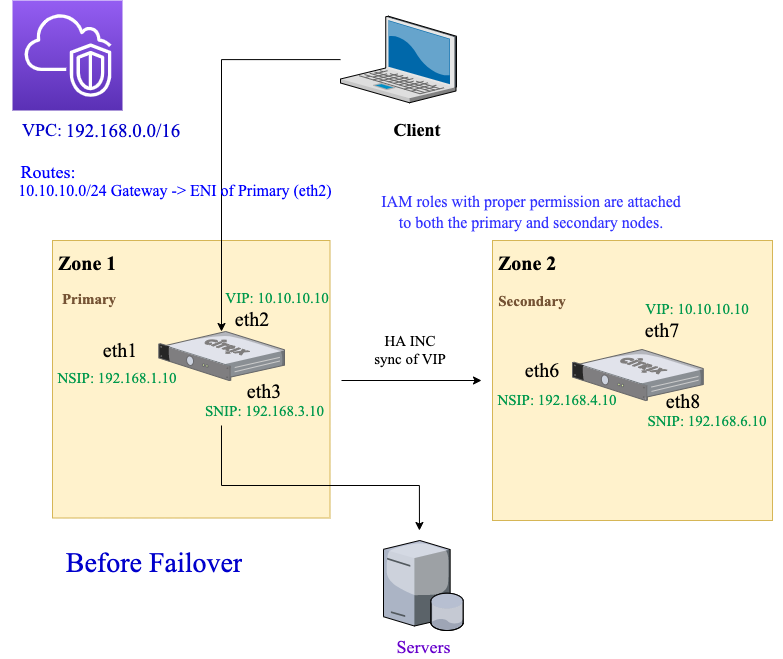
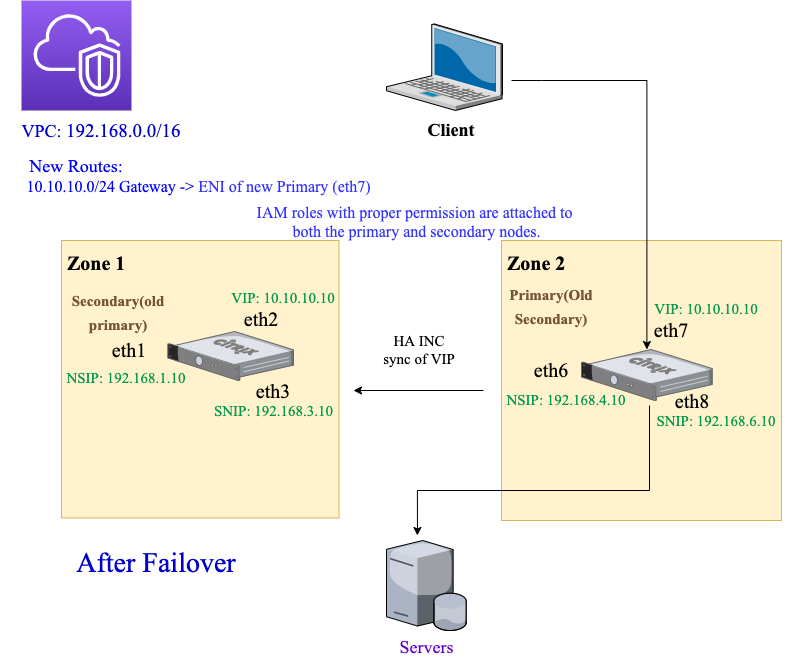
For this scenario, use CLI to configure high availability.
-
Set up high availability in INC mode on both the instances.
Type the following commands on the primary and the secondary nodes.
On the primary node:
add ha node 1 192.168.4.10 -inc enabled <!--NeedCopy-->Here, 192.168.4.10 refers to the private IP address of the management NIC of the secondary node.
On the secondary node:
add ha node 1 192.168.1.10 -inc enabled <!--NeedCopy-->Here, 192.168.1.10 refers to the private IP address of the management NIC of the primary node.
-
Add a virtual server on the primary instance.
Type the following command:
add lbvserver vserver1 http 10.10.10.10 80 <!--NeedCopy--> -
Save the configuration.
-
After a forced failover:
- The secondary instance becomes the new primary instance.
- The VPC route pointing to the primary ENI migrates to the secondary client ENI.
- Client traffic resumes to the new primary instance.
AWS Transit Gateway configuration for HA private IP solution
You need AWS Transit Gateway to make the private VIP subnet routable within the internal network, across AWS VPCs, regions, and On-premises networks. The VPC must connect to AWS Transit Gateway. A static route for the VIP subnet or IP pool inside the AWS Transit Gateway route table is created and pointed towards the VPC.
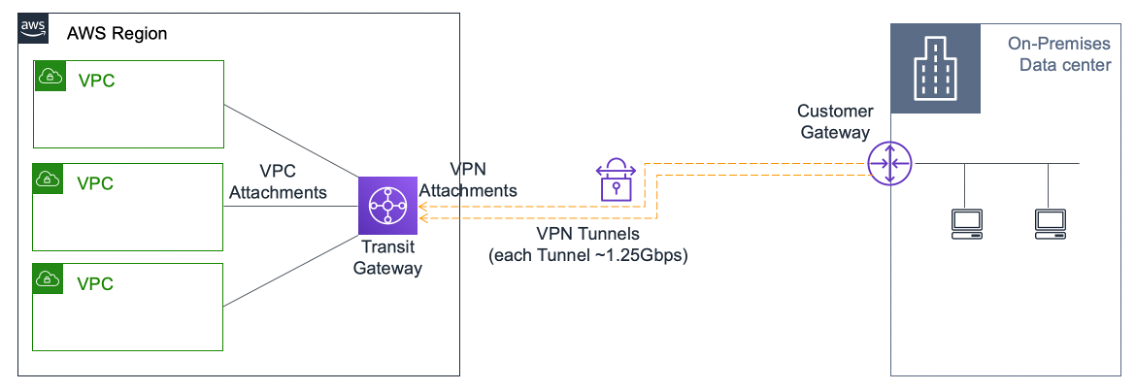
To configure AWS Transit Gateway, follow these steps:
- Open the Amazon VPC console.
- On the navigation pane, choose Transit Gateway Route Tables.
-
Choose the Routes tab, and click Create static route.

-
Create a static route where CIDR points to your private VIPS subnet and attachment points to the VPC having ADC VPX.
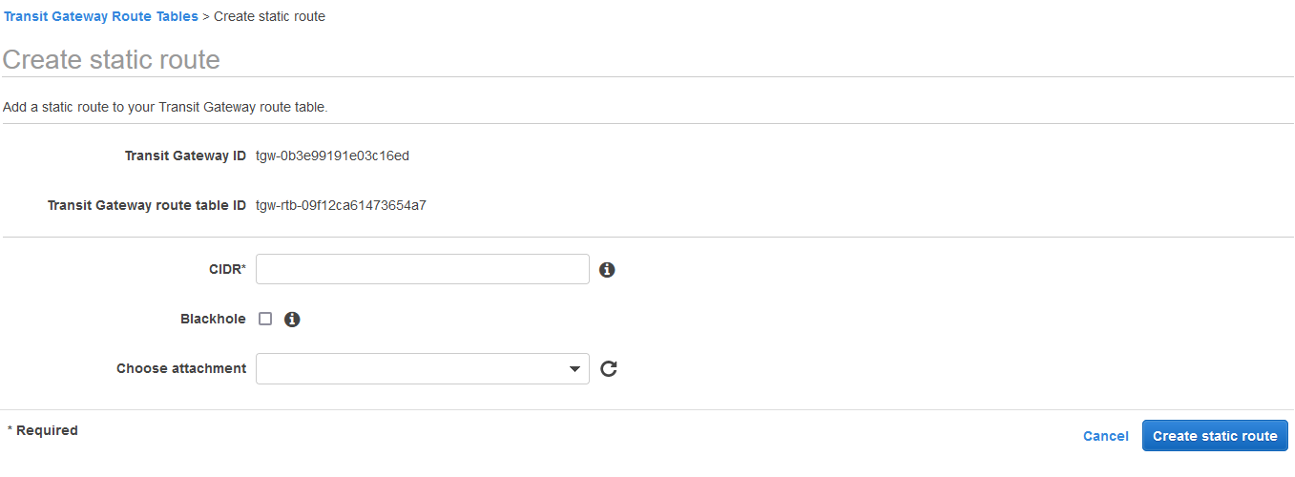
- Click Create static route, then choose Close.
Troubleshooting
If you face any issues while configuring HA private IP solution across multizone HA, check the following key points for troubleshooting:
- Both primary and secondary nodes have the same set of IAM permissions.
- INC mode is enabled on both the primary and secondary nodes.
- Both primary and secondary nodes have the same number of interfaces.
- While creating an instance, follow the same order of attaching interfaces on both the nodes. On a primary node, if the client interface is attached first and the server interface is attached second. Then, follow the same order on the secondary node as well. If there is any mismatch, detach and reattach the interfaces in the correct order.
- If traffic does not flow, make sure the “Source/dest. Check” is disabled on the client interface of the primary node for the first time.
- Make sure the cloudhadaemon command (
ps -aux | grep cloudha) is running in Shell. - Make sure that the Citrix ADC firmware version is 13.0 build 70.x or later.
- For issues with the failover process, check the log file available at: /var/log/cloud-ha-daemon.log
Share
Share
This Preview product documentation is Cloud Software Group Confidential.
You agree to hold this documentation confidential pursuant to the terms of your Cloud Software Group Beta/Tech Preview Agreement.
The development, release and timing of any features or functionality described in the Preview documentation remains at our sole discretion and are subject to change without notice or consultation.
The documentation is for informational purposes only and is not a commitment, promise or legal obligation to deliver any material, code or functionality and should not be relied upon in making Cloud Software Group product purchase decisions.
If you do not agree, select I DO NOT AGREE to exit.